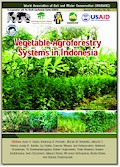| Book Chapter |
 |
|
| Title | Understory vegetable production in smallholder agroforestry systems of West Java - a viable option? | | Author | James M Roshetko, Gerhard Manurung, Anas Susila, Denta Anggakusuma and Arif Rahmanulloh | | Editors | Anas D Susila, Bambang S. Purwoko, James M Roshetko, Manuel C. Palada, Juang G. Kartika, Lia Dahlia, Kusuma Wijaya, Arif Rahmanulloh, Mahmud Raimadoya, Tri Koesoemaningtyas, Herien Puspitawati, Tisna Prasetyo, Suseno Budidarsono, Iwan Kurniawan, Manuel Reyes, Wanraya Suthumchai, Karika Kunta and Samran Sombatpanit | | Year | 2012 | | Book Title | Vegetable-agroforestry systems in Indonesia | | Publisher | World Association of Soil and Water Conservation (WASWAC), Bangkok, Thailand and the World Agroforestry Center (ICRAF), Nairobi, Kenya | | City of Publication | Bangkok, Thailand | | Number of Pages of the book | 29 | | Pages | 19-47 | | Call Number | BC0331-12 | | Keywords | Vegetable production, tree shade management, vegetable agroforestry systems |
|
| Abstract: |
| Farmers in Nanggung, West Java, traditionally cultivate vegetables under
full sunlight. There is opportunity to expand vegetable production in the under-
story of agroforestry systems, but farmers have limited experience with such prac-
tices. An on-farm trial evaluated the production of nine commercial vegetable spe-
cies (of which seven subsequently survived) under three light levels as the treat-
ment in a nested design, replicated three times. Average light levels for each
treatment were 127-603 *1000 lux (open area, control), 95-245 *1000 lux (medium
light) and 75-135*1000 lux (low light). Relationships between a number of site/
overstory variables and vegetable growth and yield were explored. Results indicate
that in an understory of mixed tree systems with medium light level, the
production per plant of amaranth ((Amaranthus sp.), kangkung4 (Ipomoea aquatica Forsskal), eggplant (Solanum melongena L.), chili (Capsicum annuum L.), tomato (Lycopersicon esculentum Miller), yard-long bean (Vigna unguiculata L. Walp.) and katuk (Sauropus androgynous L. Merrill) was superior to production under
full sunlight (from 98 to 278%). Even in understory of low light levels (heavy
shade), those seven vegetables produced 43-139% of the full sunlight plot
production. Because the trial was managed with hired labor and at an intensity that
exceeded smallholder practices, vegetable production costs representative of
smallholder conditions could not be documented. However, illustrative data
demonstrate the production costs/kg were lowest under medium light levels for all
vegetable species. This study requires replication to address questions of vegetable
quality and seasonal variation, cropping rotation, tree-vegetable-site matching,
labor input requirements, and overall profitability under varied light levels. Results
from those studies will inform the development of efficient and effective practices
for understory vegetable production in smallholder agroforestry systems. |
|